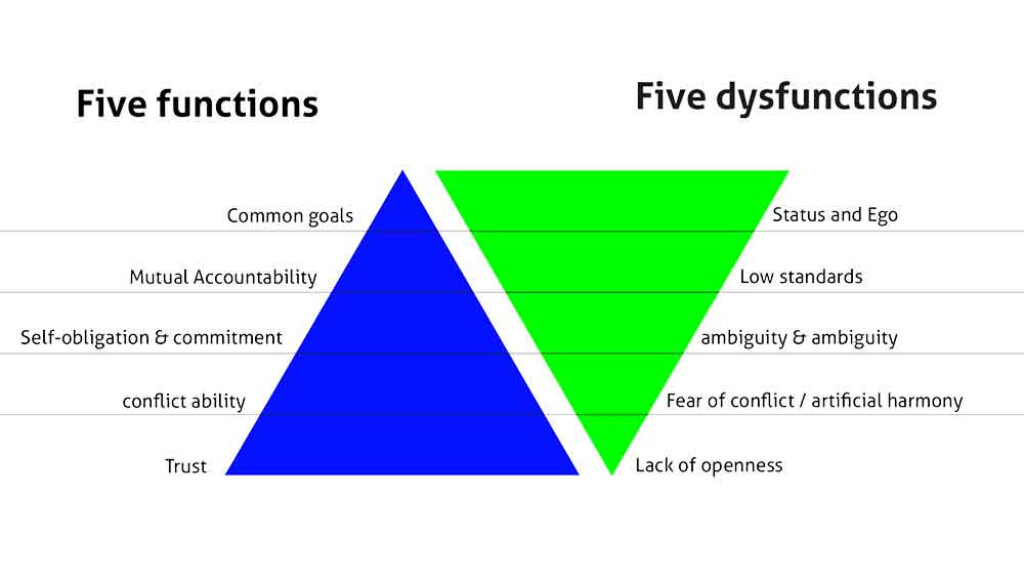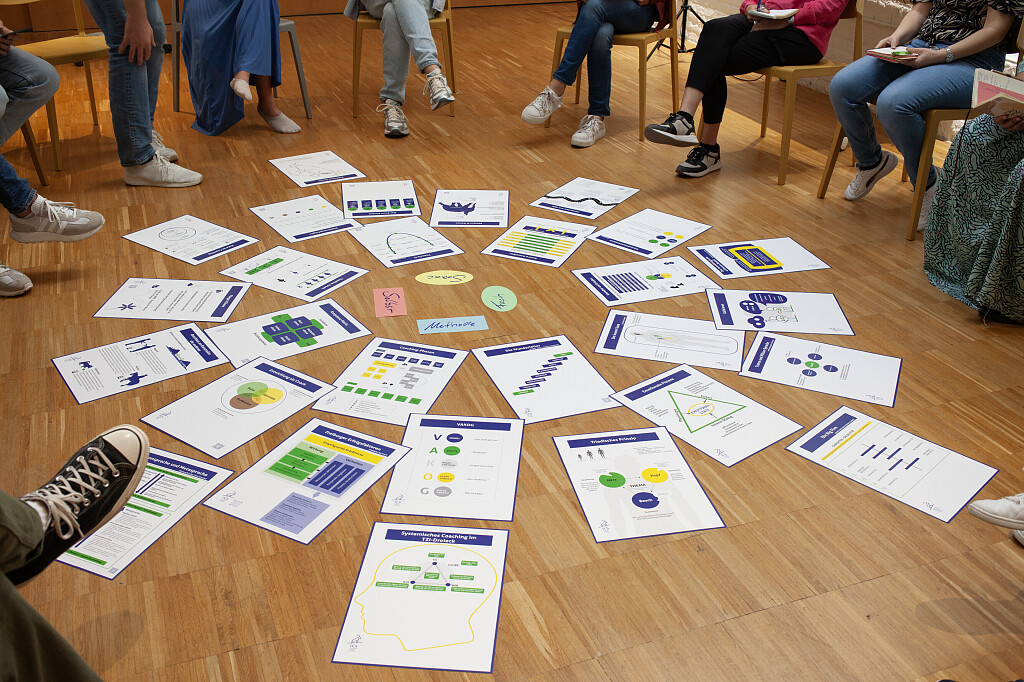From Dysfunction to Function
The Five Functions of a Team outline a clear roadmap to success:
Trust, Conflict, Commitment, Accountability, and Results—these are the five essential steps to achieving team success. Inspired by Patrick Lencioni’s “The Five Dysfunctions of a Team,” this model takes a “reverse engineering” approach: it identifies potential pitfalls (dysfunctions) and translates them into actionable functions to promote success.
Like other thought leaders, Lencioni approaches successful teamwork by examining factors that lead to team failure. By reversing these factors, he provides valuable tools for leaders: visible dysfunctions offer insights into corrective actions, while visible functions indicate areas to maintain and develop.
This model serves as a guide for teams seeking to actively engage with their performance.
A Visual Model for Team Reflection
Graphically, Lencioni’s model is often depicted as a pyramid, while other authors illustrate it as a staircase. Each level is foundational for the next. By working with this model, teams can identify their strong points and areas needing improvement.

Reflection and Analysis: Addressing Functions and Dysfunctions
The basis for all reflective and analytical activities with this tool is the exploration of individual functions and their underlying dysfunctions.
Function 1 (F1): Trust as the Foundation // Dysfunction 1 (D1): Lack of Openness
Trust is essential for team collaboration. At a factual level, team members must rely on promises being kept. Interpersonally, everyone should feel safe.
Function 2 (F2): Constructive Conflict // Dysfunction 2 (D2): Fear of Conflict – Artificial Harmony
Different ideas, needs, and opinions are valuable to a team, offering a broad perspective. This diversity can help develop the best common ground, provided it is seen as a resource. Otherwise, it leads to conflicts, power plays, and office politics.
Function 3 (F3): Commitment // Dysfunction 3 (D3): Ambiguity and Uncertainty
With trust and a solid common ground, team members can make clear commitments. Functional teams define: Who does what by when. Dysfunctional teams exhibit unclear agreements, ambiguity, and resulting misunderstandings, unfinished tasks, or duplicated efforts.
Function 4 (F4): Accountability // Dysfunction 4 (D4): Low Standards
In high-functioning teams, members not only fulfill their tasks but also hold each other accountable and push for excellence. Dysfunctional teams accept excuses and subpar work.
Function 5 (F5): Focus on Results // Dysfunction 5 (D5): Self-Interest
Teams that set high standards and work towards common goals develop a strong team spirit. Successes are celebrated collectively, with mutual recognition. In dysfunctional teams, individuals seek personal victories, engage in strategic positioning, and undermine colleagues.
From Trust to Results – A Summary
With trust (F1), teams can address diverse perspectives (F2). Without trust (D1), artificial harmony (D2) emerges, reducing the willingness to address conflicts. Utilizing differences as strengths (F2) allows for clear commitments (F3). Artificial harmony (D2) leads to suppressed opinions and avoided responsibilities (D3), resulting in unmet agreements and lack of accountability (D4). This fosters unreliability (D3) and endangers team cohesion (D2).
Clear commitments (F3) enable members to demand contributions from others (F4), as the common ground (F2) and trust (F1) are established.
In dysfunctional teams, individuals pursue personal goals (D5). Another’s failure is seen as beneficial to their own success, leading to internal competition rather than collaboration.
Functional teams, however, achieve common goals (F5) by setting high standards (F4), fulfilling commitments (F3), maintaining constructive dialogue (F2), and building trust (F1).
Turning Insights into Action
Applying the model of the 5 (dys)functions
Present the five functions and dysfunctions to your team in a meeting and analyze where the team currently stands. Which levels are secure? Which levels are challenging? Which level seems unattainable?
Through joint reflection, you can derive individual actions to integrate into daily team activities, enhancing secure levels and stabilizing weaker ones.
Guiding questions for addressing team functions:
How can you build trust within the team?
How can you establish a communication and feedback culture that allows for conflict resolution?
How can individuals contribute effectively to team efforts?
How can you develop mutual understanding and shared responsibility within the team?
How can you establish and maintain common goals?
Each level can be addressed through dedicated workshops to strengthen the team. This tool can also be used individually as an analysis instrument to reflect on personal leadership or team performance and derive specific action steps.




